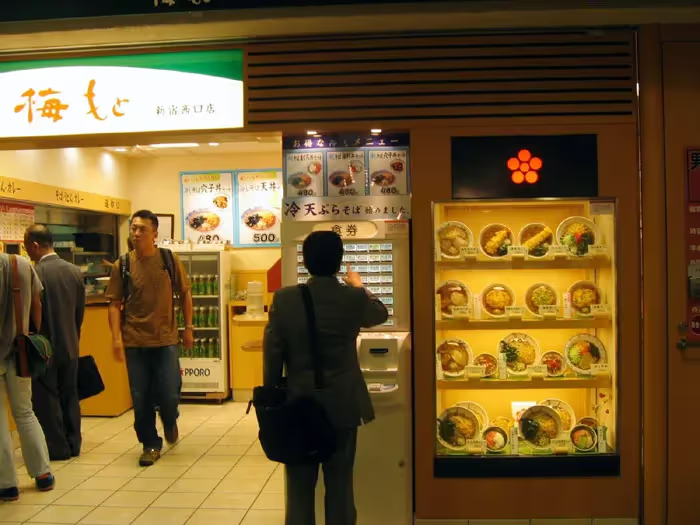A biweekly newsletter with public space news, resources, and opportunities.
A curated dispatch on all things public markets plus the latest announcements from the Market Cities Program.
Please note that these Hall of Shame nominations were written in a moment in time (most over a decade ago) and likely have since changed or even been transformed. If the above entry is now great, or still not so great, go ahead and comment below on how it has evolved or nominate it as a great place.

A multi-use transfer point for all main lines of mass transit in Tokyo, this station is filled with people from 7 a.m. to 10:30 p.m. every day of the week.

Shinjuku Station is approximately 15 acres. The station serves four light rail train companies; has two underground levels for the subway trains; two high-rise department stores above the first level; retail uses at all levels including restaurants, shops, boutiques, drugstores, lockers; several entrances connected to the streets that serve as bus depots; shuttle pick-up to the airports; taxi stands; grocery stores; underground passages to high rise buildings including the Tokyo Metropolitan Government offices (City Hall); and performance space for cultural events. Four train companies use this as a transfer point. One train company has as many as 12 tracks. Although I did not make a conscious effort to count the number of tracks, I approximate 30 tracks, not including the subway lines. The Japanese know how to use their valuable space efficiently. This is urban development at its best; you can go to one spot in the city and have a gazillion of choices of activities to do. There are no dead spaces in this station. Every square foot of real estate has its function, including the locker areas, restrooms, police station, telephone booths, etc.
The train station is open to all streets. Imagine a spider web with Shinjuku Station in the middle and Tokyo streets connected radially from it. You can access the station from many parts of the downtown (Shinjuku) and the trains obviously connect Shinjuku station to the whole city. Wayfinding is easy, because there are signs every 10 feet, and the signs are in Japanese and English. There is a direct passage to the Tokyo Municipal Government Building, as well as all adjacent high rise offices. You can do your shopping at the department stores right in the train station, or have a quick dinner at one of the take out soba places, or grab some toiletries at the small drugstores in the station.
Plenty of public rest rooms, which are relatively clean and provide both the Western style (toilet seat) and Asian style (squat). The place is amazingly clean considering the 100,000Ís of people that use this space everyday, and the fact that there are no litter receptacles (due to the terrorist attack on one of the trains in the past). There is a police station inside the Shinjuku Station and I felt completely safe walking around, shopping, eating at restaurants, or catching my train. To someone who lived in an American suburb, Shinjuku Station could be overwhelming, but to someone like me who's always lived in crowded cities, such as Manila and Hong Kong, I am completely at home with the massive crowd.
Since it is a transfer station for trains, buses, taxis and shuttles to the airport, most people are there to catch their trains. It is common to see phalanxes of people coming out of one train line row of turnstiles and going in all directions to catch their next train. Shinjuku Station is packed with people from 7:30 a.m. to 10:30 p.m. everyday. However, because the shops are so conveniently located, I saw people going for happy hour, or shopping at the department stores after work. There was a traditional Japanese drum performance one day and I saw people milling around to watch the performances.
Shinjuku Station is one of the most common meeting places for people because it is the point where all trains in Tokyo converge, so it is convenient to use as a meeting place. The fact that there are multiple restaurants, department stores, even a performance area, draws crowds to the station. However, the majority of the people are enroute to other destinations.
It is customary for the train companies to own department stores and hotels in the train station. So unlike in the US where this will take a complex deal-making among several developers (one for the hotel, one for the department store, and one for the train company), the Japanese approach makes it easy to develop a multi-use train station because of their business approach. The Soba Fastfood restaurant (pictured above) is a unique Japanese invention. You pick what you want to eat through the vending machine, with the help of plastic food display to give you an idea what to expect. The vending machine issues a ticket which you present to the cook/restaurant staff. Great for foreigners like me who do not need to communicate by words to the restaurant staff. The food comes out in a minute.





*Please note that these Hall of Shame nominations were written in a moment in time (most over a decade ago) and likely have since changed or even been transformed. If the above entry is now great, or still not so great, go ahead and comment below on how it has evolved or nominate it as a great place.